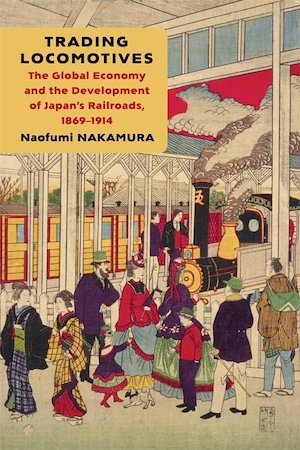Naofumi Nakamura Trading Locomotives: The Global Economy and the Development of Japan’s Railroads, 1869–1914 Columbia University Press 272 pages, ISBN: 9780231218467
In a nutshell
In this book, I examined the history of Japan’s railroads, focusing on the locomotive trade and technological development from a global perspective. As railroads were a key industry of the Industrial Revolution, their worldwide proliferation proved integral to the emergence of a market-based global economy at the turn of the twentieth century. Japan’s railroads played an essential part in that story, and this book highlighted the international momentum that enabled the development of this industry by reconsidering the connections between the first global economy and the Industrial Revolution in Japan. In addition, I reevaluated the relationship between global and local events by examining how Japan, a relatively underdeveloped country during this time period, attempted to resist the forces of globalization through the localization of locomotive manufacturing. These processes also marked the beginning of Japan’s imperial expansion while advancing its national formation in response to globalization.
My book also examined the links between the nation-state and empire-building in terms of railroad development. The railroad—first introduced and developed as an essential tool for Japan’s nation-state building—was transformed into a tool for empire-building after the late 1890s. For locomotive manufacturers, it took Japan too long to acquire the technology required to build railroads throughout its empire. Thus, in the short term, Japan’s empire-building provided an expanded market for Western locomotive manufacturers. However, Japan succeeded in localizing and mass-producing large locomotives just before WWI and began transferring and exporting them to its colonies and spheres of influence. In this aspect, the government-led technology transfer and development promoted domestically educated engineers and rapidly grew Japan’s empire.
The wide angle
Let me share my personal perspective on my research journey. My interest began with the fascinating question of Japan's industrialization. How did Japan, a small island nation viewed by the West as a distant frontier, embark on rapid industrialization after the Meiji Restoration and quickly catch up with Western powers? I believed that to understand this phenomenon, it was essential to explore the mechanisms of the Industrial Revolution, which serve as the foundation for industrialization. This led me to focus my research on Japan's own Industrial Revolution.
Initially, my attention was directed toward the railroad industry, which was one of the key sectors in Japan's Industrial Revolution. A significant aspect of railroad development in Japan was the strong support it received from local communities, which played a crucial role in establishing many railroad companies. However, starting a railroad company demanded considerable capital, diverse technical expertise, and skilled management. This raised the question: how did these local communities manage to secure the necessary managerial resources? To find answers, I investigated the local economies during the era of the Industrial Revolution. My research uncovered a financial foundation and human networks that supported local industrialization. However, it remained unclear how the essential materials and engineers for railroad construction and operation were procured. Consequently, I shifted my focus to understanding why railroad materials and engineers, crucial for its construction and operation, were smoothly supplied to Japan, despite its location in the Far East. This forms the core research question of this book.
In this book, I examined material procurement in Japanese railroad companies from various perspectives, focusing on its connection to the global economy during the transition between the 19th and 20th centuries. This discussion ties into debates in international business history, particularly regarding the role of Japanese trading companies and the beginnings of global marketing by American manufacturing firms. This book also explores the autonomy of Japanese engineers and their original technological advancements in locomotive manufacturing, providing a crucial case study in the history of technology. Additionally, one of the research perspectives introduced in this book—examining the interplay between globalization and localization in the context of locomotives—is expected to present new arguments within the global history of mechanical products. Furthermore, another significant context of this book is the exploration of the relationship between nation-state building and empire building, particularly regarding Japan's railroad development. This topic is a central theme in modern Japanese history.
A close-up
I hope that they would take a moment to compare the photograph on page 186 with the locomotive photograph on page 187. Although the two locomotives appear very similar, there is one significant difference between them. The German locomotive on page 186, which served as the model for the locomotive on page 187, features four leading wheels (designated as 4-6-0). In contrast, Japan's first domestically produced large locomotive, on page 187, has only two leading wheels (designated as 2-6-0). As a result, the Japanese locomotive is shorter and lighter than the German model. However, their tractive forces are nearly identical. Given Japan's narrow gauges and mountainous terrain, characterized by few flat areas and weak ground conditions, the development of a smaller and lighter locomotive that retained the power output of its German counterpart was a remarkable achievement. It was also one of the technological innovations and product differentiations developed by Japanese engineers. For Japan's locomotive manufacturing industry, this advancement signified the success of localization in response to globalization. What made such technological development possible? I provide a detailed explanation in Chapter 6 of this book. The significant points are as follows:
The first global economy facilitated technology transfer through Japan’s strategy of ordering target machine models from overseas, dispatching domestic engineers as supervisors to absorb the technology, and ultimately acquiring the technology—including the production process—through imitation production. The pivotal role of Japanese engineers in this global technology transfer cannot be overstated. Western manufacturers, in their quest to secure orders amidst intense international competition, demonstrated remarkable adaptability. To the maximum extent possible, they strived to meet the demands of orders from Japanese shipyards and railroads. Moreover, the Navy was Japan’s only consumer of warships, and the IGR monopolized over 90 percent of the country’s domestic locomotive market. European and US manufacturers competing for large orders could not ignore the demands of these key customers, while their German peers were obliged to accept Shima and Asakura as inspectors and disclose manufacturing process details at the IGR’s request. In this way, the Navy and the Railway Agency used global competition to localize technology (p.184).
Lastly
First, I aimed to present a global history centered on locomotives in this book. While these machines were recognized as international commodities from the start, their understanding largely remained limited to being imported foreign products within individual countries, and research that offered a global market perspective was scarce. In contrast, this book provided a new international perspective by examining the case study of Japan. Moving forward, there is potential to develop this approach further and expand the global history of market development, competition, technology, and organization within the international market for mechanical products. I hope this will inspire new avenues for research.
Second, this book marks the initial step toward a comprehensive study of the relationship between railroads and empire building in modern Japan. While previous research has established that railroads were instrumental in imperial expansion, studies exploring the overall role of railroads in the Japanese Empire are still in their early stages. This book surveys the entire East Asian region through the lens of locomotive market trends, providing an overview of Imperial Japan's position and influence in the early 20th century. In the future, I plan to broaden the time period under examination and collaborate with scholars of Chinese, Taiwanese, and Korean history to advance this research topic.
Finally, I would like to discuss the significance and role of overseas marketing by American manufacturing firms in the early 20th century, which is the focus of this book. As is well known, American manufacturing companies began their full-scale expansion into international markets from the late 19th century into the early 20th century, ultimately evolving into large multinationals. However, the question of who pioneered these foreign markets and the methods they used during this initial phase remains unresolved. In the future, I believe that introducing a new research perspective on the history of multinationals will be possible by comparing and examining the marketing activities of American companies not only in Japan but also in other regions, such as the Asia-Pacific.





